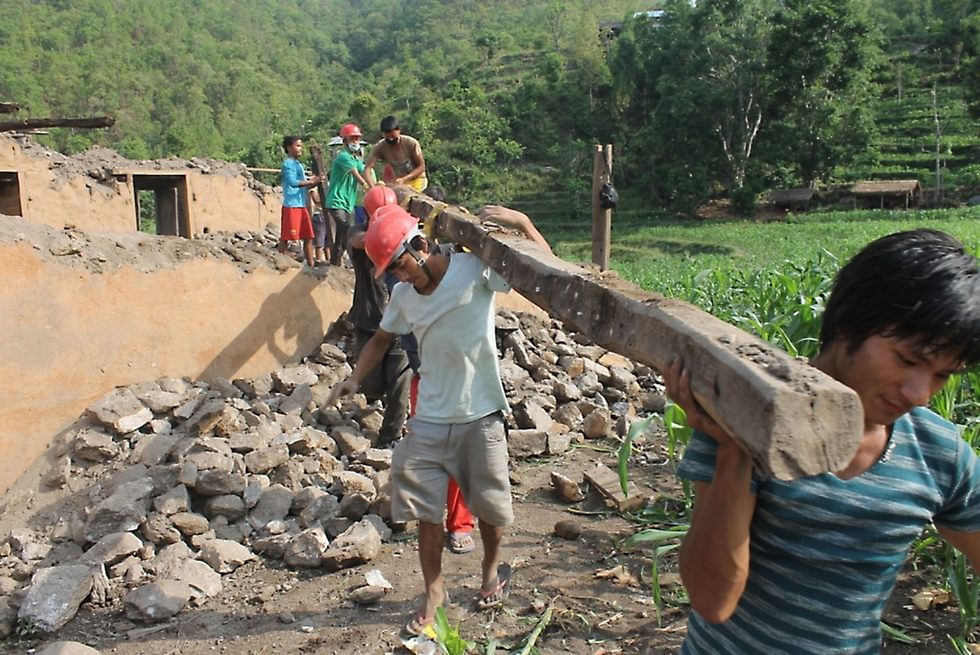Situating the Earthquake in the Politics of Feudal Bureaucracy
From the Series: Aftershocked: Reflections on the 2015 Earthquakes in Nepal
From the Series: Aftershocked: Reflections on the 2015 Earthquakes in Nepal

Three weeks after the second earthquake in May 2015, I asked a Kathmandu taxi driver from Sindhupalchowk if the government had delivered the promised tarpaulins to his village, less than three hours from Kathmandu. He sneered: “As if the government would give! I just returned, after making my own arrangements for my decimated house. The government only looks after itself.” The taxi driver’s dismissal echoed public sentiments about the government’s inefficient post-earthquake intervention. This sense of shared frustration, however, has deeper roots.
Following the introduction of multiparty democracy in 1990, the predominantly Hindu, high-caste men who headed once-underground political parties took over the mantle of political power and the feudal state structures in which it was vested. The promise of democratic institutions, new forms of political practice, and a culture of citizen-state relations based on accountable governance was almost immediately thwarted by emerging party dynamics.
Reflecting the hierarchical nature of Nepali society, these older, high-caste men established personalized and centralized rule. Sustaining patronage networks became vital in order to maintain political cadres and support in the emerging landscape of democratic competition (Hachhethu 2008). The result was the informal distribution of state resources through political patronage networks. After 2006, these dynamics were further reinforced by the Maoists and Madhesi parties (International Crisis Group 2010). Political power remained personal rather than institutional, with patrimonial traditions and patron-client relationships dominating political institutions. The absence of elected officials at the local level and the consequent introduction of the All-Party Mechanism also contributed to the spread of patronage systems, impunity, and corruption.
In the context of ever-expanding webs of patronage, the politicization of the civil service has been widespread. With little concern for democratic rules and procedures, political elites have shown no real commitment to making state institutions stronger or more inclusive. An evaluation system that lacks transparency, in which rewards and disciplinary actions are delinked from performance, offers little incentive for change in feudal state institutions (Shakya 2009). For civil servants, it is service to the powerful that counts; failure to deliver services and or to respond to common citizens is unimportant (see Tiwari 2009, 22). It is not in the interest of bureaucrats to build relations, trust, and confidence with citizens. In this entrenched political culture, accountability remains rhetoric and public services are weak.
In the years since 1990, there has been little change in the composition of the historically exclusionary state. According to the Archive of the Civil Service, in 2013 high-caste Bahun/Chettris constituted 70 percent of the highest-ranking civil service officers, with Newars at 12 percent, Tarai/Madhes at 13 percent, and Janajati at 4 percent, with Dalits and Muslims at 0.8 percent and 0.7 percent respectively. Less than 8 percent of civil services officers were women, and of that total, Bahun/Chhetri and Newar women constituted 88 percent.
With the dominance of high-caste, male Hindus and the overrepresentation of bureaucrats with parents from agricultural backgrounds, scholars have argued that “traditional norms and values are likely to be strong in the bureaucracy, with an emphasis on hierarchy, ascription, rank and status” (Jamil and Dangal 2009, 198–99). A culture of hierarchy and expected deference to officeholders does not easily lend itself to service-oriented norms and values.
Moreover, the narrow ethnic, caste, region, and gender base of the civil service means that many (especially in the higher echelons) have little or no connection to the communities they are supposed to serve. Institutional discrimination and detachment add to the reluctance of the bureaucracy to serve citizens’ interests. The inability and unwillingness to respond to citizens’ demands and concerns erodes trust and the legitimacy of the state.
Reactions to the Nepali government’s earthquake response must take into account a context where the state has long been seen as unresponsive, self-interested, and—for many—predatory. Historically structured not to serve but to rule, the state has held little legitimacy among marginalized groups. High levels of corruption and a lack of accountability in local government—the scale with which citizens have the most immediate contact—is perceived as further proof of the ruling state’s disinterest. These institutions continue to be viewed as entities that are inaccessible and disengaged from the everyday wants and needs of citizens. As a result, many excluded groups have little reason to trust in the fundamentals of the state system. A 2010 study of trust in local government, which focused on Lalitpur municipality, revealed that Janajatis were half as likely to trust the municipality than the non-Janajati population (Pande 2010, 46).
Today, citizens of Nepal feel alienated from state structures, and this contributes to their reluctance to engage with the state amidst a sense of helplessness and frustration. Paradoxically, while little is expected from the state, the state remains central to the demands of citizens. The slow and inadequate response of political leaders and bureaucrats to the earthquake has to be situated in this historical, political, social, and cultural context.
Hachhethu, Krishna. 2008. “Nepali Politics: People–Parties Interface.” In Resistance and the State: Nepalese Experiences, edited by David Gellner, 133–76. New Delhi: Social Science Press.
International Crisis Group. 2010. “Nepal’s Political Rites of Passage.” Asia Report, no. 194.
Jamil, Ishtiaq, and Rameshwor Dangal. 2009. “The State of Bureaucratic Representativeness and Administrative Culture in Nepal.” Contemporary South Asia 17, no. 2: 193–211.
Pande, Bhakta Bahadur. 2010. “Citizens’ Trust in Local Government: A Study of Lalitpur Submetropolitan City in Nepal.” Master’s thesis, North South University, Bangaladesh.
Shakya, Rabindra K. 2009. “Why Civil Service Reforms Fail?—A Case of Nepal.” Administration and Management Review 21, no. 2: 40–63.
Tiwari, Madhu Nidhi. 2009. “Governance Reform in Political Transition: The Case of Nepal’s Civil Service Reform.” Nepalese Journal of Public Policy and Governance 24, no. 1: 1–27.